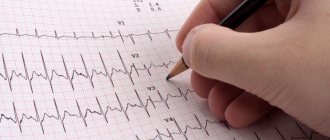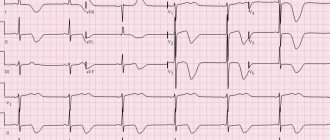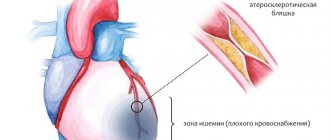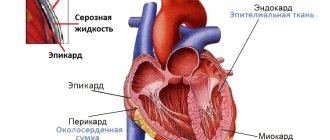What is the circadian index and what is the norm?
This indicator is calculated from the average values of daytime and nighttime heart rate. The first period is based on the time when a person is awake. It does not matter whether this happens during the day or in the evening. To get the second figure, it is necessary to take heart rate indicators throughout the person’s sleep. Typically, the periods from 7:00 to 22:00 and from 23:00 to 6:00 are taken for calculation.
Under certain circumstances, the circadian index may change. Increased or decreased readings may persist for several days due to situational reasons. But more often this indicates the development of a serious pathology that requires treatment. To calculate CI, use the formula “average heart rate during the day/average heart rate at night. Normally, the circadian index should be within the range of 1.24-1.44. In the survey results it is indicated as a percentage, i.e. 124-144%.
Symptoms of change
Each disease has its own manifestations, and determining the circadian index requires consultation with a medical professional. Symptoms that are alarming and require an appointment with a therapist or cardiologist for daily monitoring:
- dizziness, disturbances of consciousness without head injuries;
- frequent or rare heartbeat of a permanent or temporary nature;
- irregular pulse (different time intervals between heartbeats);
- pain in the chest on the left, especially if it occurs against the background of exertion and radiates to the arm;
- any of the listed symptoms, if they appeared while starting to take medications to correct heart rhythm;
- difficulty breathing, cough, chest pain, worse with exercise.
The listed symptoms are not always accompanied by changes in the cyclicity of the heart, but any of them, and especially their combination, is a reason to immediately consult a doctor.
Circadian Index Abnormalities and Symptoms
The difference between night and daytime heart rate can be increased or decreased. in the first case, the Circadian index is increased. It is diagnosed if the levels exceed 150%. This does not always mean that pathology of the heart muscle is developing. Increased CI occurs in athletes. If there are no symptoms of deviation, there is nothing to worry about. However, if any of the listed signs of circadian index disorder are present, you should consult a doctor. These include:
- dizziness that appears periodically;
- fainting (unless there are other reasons for it, such as head injuries and brain diseases);
- shortness of breath with little or no physical activity;
- chest pain, including that occurring during exercise;
- cough, feeling as if the heart is skipping beats;
- headache for no reason;
- extrasystole (heart contractions outside the normal rhythm);
- nausea and vomiting;
- high or low blood pressure (due to wear and tear of blood vessels).
Such symptoms indicate decreased circadian index values. The average day and night heart rates should not differ by less than 1.2 or 120%. Such QI is called rigid. It occurs less frequently than enhanced. The reasons why the deviation occurs are no safer than pathologies that cause an increased circadian index. Elevated readings mean that the myocardium is too sensitive. Rigid CI may be a sign of autonomic denervation of the heart.
Attention! It is impossible to make a diagnosis based solely on disturbances in the difference between daytime and nighttime heart rates.
This requires a complete examination.
Features of treatment
The essence of therapy is the correction of the underlying pathology. The circadian index is not specifically normalized; there are no methods for such adjustment. During the treatment process, the goal is to restore the contractile function of the myocardium. Treatment can be conservative and surgical.
General principles of conservative therapy:
- timely diagnosis and treatment of CHF;
- individual medication correction regimen;
- use of innovative methods of therapy;
- pressure balancing in the pulmonary trunk;
- blood sugar stabilization.
To relieve clinical manifestations and eliminate the trigger, the following is prescribed:
- antiarrhythmics: Amiodarone, Quinidine in short courses (not used due to the mass of side effects);
- antihypertensive drugs of different groups: diuretics (Spironolactone, Triampur), ACE inhibitors (Capoten, Monopril), calcium antagonists (Norvasc, Amlodipine), centrally acting agents (Renitek, Enap), beta blockers (Concor, Betaloc);
- cardiac glycosides (Digoxin, Celanide);
- statins (Rosuvastatin, Atorvastatin):
- anticoagulants-antiplatelet agents (Clopidogrel, Warfarin).
Surgical intervention is carried out in extreme cases, for health reasons: heart defects of any origin - congenital or acquired, aneurysms, injuries. They perform valve replacement, restoration of the tightness of the heart chambers, stenting, ballooning, bypass surgery, and transplantation of sections of the great vessels or heart.
Sometimes radiofrequency ablation (cauterization) is preferable for blockades of conduction pathways. The choice of operation is always the prerogative of the doctor.
After surgical correction, the patient needs to radically change his lifestyle: give up bad habits, balance his diet (including drinking), eliminate overeating, control weight, engage in dosed physical activity, ensure proper sleep (sometimes with the use of sleeping pills). In this case, the circadian index can be a good assistant for regular calculations and clinical monitoring.
Reasons for increasing QI
An increased circadian index occurs for many reasons. The large difference between daytime and nighttime heart rates occurs due to physical changes in the heart. This occurs in professional athletes. Their body is trained to such an extent that it can withstand heavy loads during the day. At night, the pulse of such people decreases almost to the permissible limit, because... spends almost no energy on maintaining the functioning of the body. Elevated QI values do not pose a health risk if a person falls into this category.
However, more often problems with CI arise due to serious illnesses. For example, the cause may be ventricular or atrial tachycardia. With such a deviation, the pulse can increase to 90 beats per minute. The pathological condition manifests itself at rest. An increase in heart rate occurs most often on days, which is why the circadian index is more than 150%.
The cause of increased CI may be sympathicotonia. This condition is characterized by increased tone of the nervous system. It is often accompanied by hypertension and tachycardia. The pathology may be congenital. At the same time, sympathicotonia is not considered a disease and is often called a manifestation of VSD (vegetative-vascular dystonia or autonomic dysfunction). Also, the causes of an increased circadian heart rate index include:
- damage to the parasympathetic nervous system;
- ekestrasystole;
- long-term use or overdose of beta-blockers;
- increased pressure in the pulmonary artery;
- innate activity of the parasympathetic part of the nervous system.
Causes, symptoms and treatment of increase and decrease
In practical medicine, deviations of this index are observed both upward and downward.
The main reasons for the change in this indicator are indicated in the table:
| QI value | Circadian profile | Causes |
| > 1,5 (150%) | Reinforced |
|
| < 1,2 (120%) | Rigid |
|
Thus, a normal circadian profile indicates a stable autonomic organization of the circadian rhythm.
If CI is elevated, this is a sign of high sensitivity of the myocardium to sympathetic stimulation. In some cases, an enhanced circadian profile is the individual norm of a person accustomed to intense physical activity.
A decrease in qi is an unfavorable sign indicating autonomic denervation of the heart. This means that the sympathetic and parasympathetic divisions of the ANS regulate myocardial contractions incorrectly. If the indicator persistently deviates downward, we can say that myocardial contractility has decreased, and the patient has developed irreversible changes in the myocardium and CHF.
When changes in the circadian index occur, the patient may experience various clinical manifestations.
All of them are associated with the underlying disease:
- attacks of dizziness;
- fainting not associated with head trauma;
- subjective feeling of interruptions in heart rhythm - increased or slowed heart rate;
- arrhythmia of the pulse (different intervals between pulse waves);
- squeezing, pressing pain in the chest area, sometimes spreading to the left half of the neck, shoulder, arm;
- shortness of breath and difficulty breathing, aggravated by physical activity;
- decreased tolerance to stress.
If you have such complaints, be sure to consult a cardiologist and undergo Holter (24-hour ECG monitoring).
While an increased circadian rhythm usually has a favorable prognosis and can be successfully treated with lifestyle changes or antiarrhythmic medications, a CI of less than 120% usually causes serious concern among doctors.
In cases where the indicator is significantly reduced, decompensation of heart failure and even the risk of death can be assumed. This condition must be treated.
Therapy is based on:
- timely detection of CHF;
- individual selection of drugs for the correction of heart failure (cardiac glycosides, diuretics) and their dosage;
- prevention of acute disorders of tissue blood supply (myocardial infarction, stroke);
- blood pressure control;
- for patients with diabetes – maintaining stable blood sugar levels.
Since changes in this indicator are most often associated with chronic diseases, unfortunately, it will not be possible to completely get rid of them. However, a properly selected course of treatment and regular doctor’s examinations have a positive effect on the patient’s quality of life.
Additionally, each person can independently adhere to the principles of a healthy lifestyle. This helps prevent irreversible pathological changes in the heart muscle.
Recommended:
- Daily walks in the fresh air.
- Compliance with the work and rest regime.
- Get adequate sleep at least 7-8 hours a day.
- A balanced diet rich in vitamins, minerals and healthy fatty acids (omega-3, 6). It is important to exclude from the daily menu foods rich in cholesterol (fatty meat, offal, butter), canned food, pickles, marinades and food “garbage” (fast food, chips, etc.).
- After consultation with your doctor, do adequate physical activity. This could be: Nordic walking, swimming, physical therapy exercises, light gymnastics at home.
- Regular preventive examinations, and in the presence of diagnosed pathologies, follow-up with a specialized specialist.
Reasons for decreased qi
A rigid circadian index is a symptom of many serious diseases. For example, deviations in readings may indicate heart failure. This condition is caused by the organ’s inability to maintain a natural rhythm, which impairs blood circulation. In this case, the pulse may drop below normal at night, and remain at its lower limit during the day.
The cause of decreased qi is often cardiomyopathy. Due to changes in the size of the heart, its functions are impaired. Without timely treatment, such a pathology can lead to premature death in just 1-2 years. The etiology of the disease does not matter. Congenital and acquired cardiomyopathy equally affects the functioning of the organ, reducing heart rate at any time of the day. It may be secondary and develop against the background of heart disease, hypertension or vascular damage. Also, muscle deformation occurs due to long-term drug use. In addition to cardiomyopathy and heart failure, the causes of rigid CI are:
- angina pectoris;
- taking Amiodarone, Cordarone and other antiarrhythmic drugs;
- ischemic disease;
- diabetes;
- consequences of surgery.
Attention! You cannot independently determine the disease based only on a reduced circadian index. Incorrect treatment can be fatal.
Reasons for decreased qi
The factor is always cardiac.
- Heart failure. The main pathological process that ends with a decrease in myocardial contractility, a small volume of blood ejection into the systemic circle and disruption of the functioning of all organs and systems. Poses the greatest danger. Develops as a result of a long course of arterial hypertension or a heart attack.
Read more about the symptoms of acute heart failure in this article.
- Cardiomyopathy. Growth, thickening of the walls of the muscular organ, expansion of the chambers always causes the circadian rhythm to decrease. Recovery as such is impossible. This is an anatomical phenomenon, it exists constantly. On the other hand, there is a chance of compensation through medication, then the circadian index will return to normal.
- Inflammation of the heart muscle (myocarditis, pericarditis). Autoimmune or infectious origin, when the pathology goes far in its development. It manifests itself as bradycardia, which is not typical for this diagnosis. This is a terrible sign. Urgent treatment is required. Although it needs to start even earlier, as soon as the process has begun.
A drop in CI may be the result of taking antiarrhythmic drugs. Then you need to wait a while and do the research again.
Diagnostics
You can determine the difference between daytime and nighttime heart rates using Holter monitoring. This is the name of daily observation on an ECG according to Holter. The test lasts at least 24 hours. The examination may take longer if CI disturbances occur sporadically. The maximum time is 72 hours. For the entire period of the study, special electrodes are attached to the person’s chest, which record the slightest changes in the pulse.
If the person who applied for the study also complains of high blood pressure, in addition to the ECG machine, a blood pressure cuff is placed on the shoulder. This way, the doctor can identify not only deviations in the circadian rhythm, but also detect hidden pathologies of the cardiovascular system. The method has existed for more than 50 years and is actively used throughout the world to make a diagnosis.
To identify the primary disease, the doctor prescribes additional tests. The patient must undergo echocardiography. It allows you to detect anatomical defects and determine the stage of development of the pathology. All information obtained in this way is compared with the previously collected anamnesis. If necessary, the specialist can prescribe a referral for MRI and stress tests.
Concept of CI
The human heart beats at a specific frequency, and in a graphical representation it resembles a sine wave. Normally, the resting heart rate is no less than 60 and no more than 90 per minute.
Not every patient understands what it is - the circadian index, for which it is necessary to know its meaning. This indicator allows you to determine the dynamics of cardiac activity over a long period of time (24 hours), obtain reliable information about hemodynamics and the course of certain somatic diseases.
Treatment
Deviations of the circadian profile from the norm in the presence of any symptoms indicate a developing pathology. This condition cannot be ignored, because Most diseases associated with QI disorders can lead to premature death. Based on the patient’s condition and accompanying symptoms, the doctor selects an individual course of treatment for each case.
There is no single set of drugs that can restore a healthy heart rhythm. The only principles common to therapy are those by which medications normalize heart rate:
- It is necessary to identify the primary cause of the low or high circadian index.
- It is necessary to detect concomitant diseases that may interfere with the treatment of the underlying pathology.
- Treatment will be ineffective if the pressure in the pulmonary arteries is not normalized.
- Elevated sugar negatively affects the functioning of the cardiovascular system, so correction of its level is necessary.
Attention! Before taking any medications, you should consult your doctor. An incorrectly selected dosage can aggravate the patient's condition.
When treating a low or high circadian index, it is important to maintain a healthy lifestyle. Heart rate is affected by smoking and excessive alcohol consumption. People who do not engage in physical activity are at risk. Therefore, if QI is disturbed, the patient needs to acquire healthy habits. Doctors recommend walking at least 10,000 steps daily. This allows you to keep your heart in good shape even for those who are contraindicated for intense training.
Reasons for changes in QI
Holter ECG monitoring shows the dynamics of the reaction of the heart muscle to any stimuli during the day. If this is the norm, then any physical or psycho-emotional stress causes a compensatory increase in heart rate, which normalizes after appropriate rest. During pathological processes in the cardiovascular system, the expected increase in rhythm does not occur, since the connections between the myocardium and the nervous system are disrupted. As a result, any load leads to myocardial ischemia.
The compensated version of the load in numbers is as follows: the circadian index is on average 1.32±0.06–0.08. When indicators go beyond these limits, this is a pathology, the triggers of which are:
| CI indicators | Triggers of pathology |
| Growth up to 1.5 units |
|
| Drop to 1.2 |
|
Forecast
It is impossible to say with certainty how the condition of a person suffering due to circadian index disorders will change. The complexity of treatment and the time required for recovery depend on the diagnosis. The stage of the disease also influences the duration of therapy. If it is detected at an early stage of development and does not have time to cause significant complications, a complete cure is possible.
Sometimes QI disorders occur due to chronic pathologies. Their symptoms can be relieved, significantly improving the patient’s quality of life. However, systematic taking of prescribed medications may be required. In some cases, sudden cardiac arrest is possible. A sign of irreversible disorders is the circadian index below 110%. In this case, the drugs prolong life, but do not guarantee a complete cure or stabilization of the patient’s condition. Only the attending physician can give the exact timing, based on the test data. There are factors that worsen the outcome with decreased or increased CI:
- presence of hereditary diseases;
- concomitant pathologies, in particular endocrine and neurological;
- age over 50 years;
- the need for surgery if the person is weakened and may not tolerate surgery;
- lack of results from taking prescribed medications.
HOW TO IMPROVE THE WORK OF THE “MOTOR”
It is important to understand that normal heart function depends on many factors, from poor lifestyle to constant emotional stress. In fact, our heart has a large margin of safety - it can work for up to 150 years. The following will help improve heart function and maintain its health:
- active lifestyle - just walk 5 km a day at an average pace and your heart will always be in good shape. It's only 1.0-1.5 hours of walking in the fresh air;
- a good full night's sleep - ideally it should last 8 hours a day. A daytime nap of 0.5-1.5 hours will also not hurt;
- calmness and stability - an established way of life, a constant schedule of work and rest is vital to our heart;
- Regular visits to the doctor and undergoing preventive examinations - at least once a year, after 40 years - 2 times a year.
In addition, the heart needs certain vitamins and microelements, which must come from food. Heart-healthy foods include fresh fruits and vegetables, dairy-based and vegetarian soups.
We must always remember that the health and normal stable functioning of our heart depends primarily on ourselves. In order for the “motor” to work properly, it is necessary to create suitable conditions for it and take into account the characteristics of your body.
What does deviation mean?
Due to the fact that many cardiac pathologies have a detrimental effect on the nerve fibers of the myocardium, as they progress, the value of CI changes. To assess the dynamics of the disease and adjust therapy, regular Holter monitoring is required.
A decrease in the index occurs in acute stroke and heart failure.
Deviations in values can be either up or down:
- Below 1.2 (or daytime heart rate is only 20% different from nighttime) – a rigid rhythm, which is a consequence of diseases affecting the intracardiac nervous system.
- Above 1.5 (or more than 50% excess of daytime heart rate over nighttime) is an indication that the heart rate is sensitive to sympathetic stimulation.
With a reduced rhythm, there is a risk of developing arrhythmia, ischemia, and cardiomyopathy. If therapy is not started in time, sudden death syndrome is possible.
An increase in heart rate is often observed in people with the development of nocturnal bradycardia and extrasystole. Increased heart rate occurs in trained athletes experiencing high physical activity.
Human circadian rhythm and its medical significance
The circadian rhythm of the human body is a kind of internal clock, on the correct “setting” of which many physiological processes depend. Biological rhythms are involved in the regulation of metabolism, cell replication, and hormone production. All 24 hours, these rhythms influence the central nervous system, adjusting its work to periods of wakefulness and sleep.
A number of cells in the human body adjust their activities to the circadian daily rhythm, coordinating their work with signals emanating from the neurons of the brain. These neurons can be imagined as a kind of clock, but there is still no clear understanding of the processes occurring in them.
Circadian rhythms in humans are a necessity that determines not only the time, but also the type of preferred activity in every hour and minute. The most important aspect can be called proper sleep, everything is tied to the circadian rhythm, even the ability to fall asleep and the desire to get enough sleep.
The usual period of rhythms is circadian, approximately equal to 24 hours, but everything is individual. Circadian rhythms are endogenous in nature and are caused exclusively by internal processes in the body. However, external factors can indirectly affect people's condition. For example, bright light can cause unplanned awakening and stimulation of specific parts of the central nervous system, which will not allow you to fall asleep again. Wakefulness, which should not have happened at this time, “resets” the circadian rhythm.
Even official medicine admits that there are early risers who are alert early in the morning, since their rhythms are short, and there are owls with long rhythms who cannot be active in the morning, and there is a physiological explanation for this.
Disruption of circadian rhythms has negative consequences. Such changes can be clearly seen against the backdrop of the need for long-distance overeating, when the flyer suffers from jet lag, long-distance travel syndrome, with characteristic symptoms: fatigue, weakness, loss of orientation, insomnia, apathy. Those who work on a rotational basis in the north or are often on duty at night find themselves in a similar situation.
The medical importance of circadian rhythms cannot be overstated. Constant attempts to influence one's own circadian rhythm lead to consequences such as chronic sleep and heart rhythm disturbances, depressive states, bipolar disorders, and cancer.
Naturally, instability of circadian rhythms leads to decreased performance and productivity. Lack of sleep and rhythmic rigidity reduce the ability to concentrate and think logically. At the same time, a person gets tired several times faster, and the loss of strength is felt more acutely. In addition, problems of an intimate nature are possible.
To return to an acceptable state, it is enough to adhere to a constant sleep schedule for some time. Exceptions cannot be made even on weekends. You should not overeat, sleep during the day, take stimulants or indulge in coffee.
What is enhanced circadian heart rate profile?
Various diagnostic techniques are used to assess cardiac activity. One of them, based on daily monitoring, is the identification of the circadian index (CI).
The human heart beats at a specific frequency, and in a graphical representation it resembles a sine wave. Normally, the resting heart rate is no less than 60 and no more than 90 per minute.
Not every patient understands what it is - the circadian index, for which it is necessary to know its meaning. This indicator allows you to determine the dynamics of cardiac activity over a long period of time (24 hours), obtain reliable information about hemodynamics and the course of certain somatic diseases.
The circadian index value is calculated based on Holter monitoring data. In this case, the activity of the heart is recorded throughout the day.
For the first time, such a survey was proposed by the American biophysicist N. Holter in 1961, which is why it was subsequently named after him.
Monitoring is carried out using a portable device that records a daily electrocardiogram. The information received is deciphered only by a specialist, based on the suspected or established disease.
The indicator is calculated by the formula: the average daily heart rate (HR) for the period from 7.00 to 22.00 hours, divided by the average nighttime rhythm from 23.00 to 06.00 hours.
The optimal index value in adults and children ranges from 1.22 to 1.44, the norm as a percentage ranges from 122% to 144%, i.e. in the daytime the heart rate should be 22-44% higher than in night. The average value of the indicator is 1.32 (132%) with a permissible error of 0.08 in the direction of both decrease and increase.
In order to calculate the CI rate, specialists conducted a number of experiments. They showed that in healthy people, gender and age do not affect the indicator. In children under one year old, the normal CI is 115%, after 12 months - 120% and then equals the indicators for an adult.
Due to the fact that many cardiac pathologies have a detrimental effect on the nerve fibers of the myocardium, as they progress, the value of CI changes. To assess the dynamics of the disease and adjust therapy, regular Holter monitoring is required.
A decrease in the index occurs in acute stroke and heart failure.
Deviations in values can be either up or down:
- Below 1.2 (or daytime heart rate is only 20% different from nighttime) – a rigid rhythm, which is a consequence of diseases affecting the intracardiac nervous system.
- Above 1.5 (or more than 50% excess of daytime heart rate over nighttime) is an indication that the heart rate is sensitive to sympathetic stimulation.
With a reduced rhythm, there is a risk of developing arrhythmia, ischemia, and cardiomyopathy. If therapy is not started in time, sudden death syndrome is possible.
An increase in heart rate is often observed in people with the development of nocturnal bradycardia and extrasystole. Increased heart rate occurs in trained athletes experiencing high physical activity.
One of the research methods for heartbeat disorders is Holter monitoring. Indications for its implementation are:
- rapid heartbeat, dizziness, fainting;
- suspicion of arrhythmia (the person is examined to correct the heart rate);
- the need to assess the proper blood supply to the heart muscle.
In addition, 24-hour monitoring is prescribed after a heart attack to determine adequate treatment, as well as to evaluate therapy for various arrhythmias and heart failure.
The value is calculated annually in the presence of diabetes mellitus, and more often if the glucose level is constantly significantly elevated.
Every person should be alert and consult a doctor for examination if the following signs appear:
- constant feeling of fatigue, dizziness with loss of consciousness in the absence of traumatic brain injury;
- fast or slow heartbeats;
- pain occurs during physical activity on the left side of the chest, radiating to the arm;
- strange cough in the absence of a cold, difficulty breathing.
You should be attentive to such symptoms if they appear when you start taking medications to correct your heart rate.
In some cases, only the circadian index allows us to determine the presence of changes in the activity of the cardiovascular system.
- With an arrhythmia, such as ventricular tachycardia, a person may not experience unpleasant symptoms of its manifestation. Only with the help of the CI method is it possible to determine its presence in order to further prescribe the necessary examination and adequate therapy. With this pathology, the value of CI is reduced.
- A low level of the circadian index is observed when the blood supply to the heart is impaired, after a myocardial infarction.
- Taking d-blockers can increase the CI index, which indicates the sensitivity of the heart muscle to sympathoadrenaline effects.
Often, increased intracranial pressure is detected only when measuring the circadian index, since the person has not experienced any symptoms, such as dizziness, nausea, or headache.
A special risk factor is the presence of type 2 diabetes, aggravated by hypertension. With such a combination, macro- and microvascular complications arise, blood pressure rises, myocardial hypertrophy occurs, coronary heart disease and heart failure develop.
It is for this reason that patients with diabetes need to control CI.
A high or low indicator indicates the presence of pathology. To normalize it, it is necessary to identify the cause that caused the failure. Only after this the doctor chooses a therapeutic tactic, draws up an individual treatment regimen, and prescribes the necessary medications.
But there are also general principles of therapy:
- timely diagnosis of cardiovascular diseases and identification of other causes leading to the development of heart failure;
- immediate treatment of stroke and heart attack;
- treatment of pulmonary hypertension.
In addition, constant monitoring of patients with type 2 diabetes and hypertension is mandatory.
It is impossible to completely get rid of chronic pathological changes in the activity of the cardiovascular system. But thanks to medical advances, a positive trend is currently being recorded in the treatment of such diseases.
Timely diagnosis and prescription of correct treatment can prolong the life of patients without radically changing its quality. It is important for patients to remember that therapy is long-term and often requires taking medications for life.
Each person is able to independently adhere to simple rules in order to prevent irreversible pathological changes in the functioning of the heart:
- Daily walks in the fresh air. If your work schedule does not allow it, then it is useful to walk at least part of the way to work or home, and also not to use the elevator.
- Ensuring adequate sleep of at least 7-8 hours.
- A balanced diet, a minimum of salty, smoked, spicy and sweet foods. Quitting drinking alcohol and smoking.
- Doing sports 2-4 times a week (aerobic exercise, swimming, exercise equipment) or at least simple gymnastic exercises at home.
- Timely completion of preventive examinations, high-quality treatment of infectious and colds. If alarming symptoms occur, do not delay visiting the doctor in the hope that everything will go away on its own.
It is easier to prevent a disease or start therapy at the first symptoms than to start a pathology and get complications that complicate the process of treatment and recovery. Therefore, compliance with preventive measures should become a good habit that ensures a decent quality of life.
The article provides information about what the circadian index is. Normal values of the indicator, what conditions lead to its change. Is it always about pathology, or can it be a physiological feature? Symptoms of disorders, methods of their correction.
Author of the article: Yachnaya Alina, oncologist surgeon, higher medical education with a degree in General Medicine.
The ratio of the average heart rate during the day to the average rate at night is called the circadian index in medical practice. Numerical indicators of heart rate are obtained by recording an ECG during the day using Holter monitoring. The study is prescribed by a therapist or cardiologist to evaluate the work of the heart muscle against the background of daily stress and during the period of night rest.
Formula for calculating the circadian index
The circadian index is normally in the range of 1.24–1.44. In case of serious cardiac pathology at the stage of decompensation, a decrease in the indicator of less than 1.2 is observed - rigidity of the circadian rhythm. A change in the index over 1.5 can be a physiological norm in trained people or observed during extrasystole (additional heart contractions at a normal rhythm).
A persistent downward change in the indicator characterizes a serious problem in the functioning of the heart muscle and a high risk of death. If the indicator changes upward, the prognosis is favorable, treatment is usually effective and successful.
A decrease in the circadian index is a sign of chronic heart failure. A complete cure for the disease is impossible, but well-chosen therapy will significantly improve the prognosis for life. Patients with this pathology are managed by a cardiologist; the sooner they are prescribed treatment, the higher the chance of maintaining their usual lifestyle.
Graph of circadian changes in the HF component in different age groups. HF component is a high-frequency indicator of heart function used when recording ECG
Heart monitoring reflects the muscle's response to any changes during the day. The normal reaction to physical activity is an increase in heart rate, and during the rest period the heart rate returns to normal. If the nervous connection of the heart with the nervous system of the body is disrupted, the rhythm does not increase; any load leads to a lack of blood supply to the tissues - the heart muscle also suffers, aggravating the pathology.
In healthy people and patients with compensated cardiac pathology, the circadian index averages 1.32±0.06–0.08. The main reasons for the indicator to go beyond the norm are given in the table:
Damage to the fibers of the parasympathetic nervous system (responsible for almost all natural functions: the release of secretory substances of the gastrointestinal tract, a decrease in heart rate at rest, constriction of the pupils, etc. - maximum activity during the rest period)
In patients with rhythm disturbances such as extrasystole (additional contractions of the heart against the background of a normal rhythm) or ventricular and atrial tachycardia (acceleration of the heart rate) without organic damage to the heart muscle
Primary increase in pulmonary artery pressure
Congenital vagotonia (predominant activity of the parasympathetic nervous system)
If the circadian index is reduced, this is a reason for immediate initiation of treatment, since we are talking about the transition of the compensated stage of heart failure to decompensated. Lack of treatment can lead to sudden death. An increase in the indicator is not so fatal; it is corrected quite well. Considering that any change in the circadian index is a manifestation of a disease or functional state, treatment for the underlying disease is indicated for correction. The general principles of therapy consist of:
All diseases that cause the cyclicity of the heart to decrease or increase are chronic and there is no complete cure for them, but timely and correctly selected line of therapy significantly improves the quality of life and reduces the risk of death. Treatment of pathological processes must be constant; discontinuation of drugs leads to a worsening of the condition. A poor prognosis is characterized by a persistent decrease in the indicator during treatment. A condition where the circadian index is below 1.1 is called “autonomic deinervation” - this is a sign of irreversible disorders leading to sudden cardiac arrest. Assessment of circadian rhythms of cardiac activity during Holter monitoring. Taking into account the peculiarities of Holter monitoring (ECG recording under conditions of prolonged, practically unlimited activity), we can assume the existence of a number of criteria for assessing heart rhythm that are specific only to Holter monitoring and carry new significant clinical information. First of all, these are indicators of circadian ECG changes. When assessing the circadian heart rate profile based on the results of Holter monitoring, the circadian index (CI), an indicator calculated as the ratio of the average daytime to average nighttime heart rate (Makarov L. M., 1999), has proven to be the most informative. CI belongs to the field of HRV time analysis methods. The determination of CI is widely used when assessing the results of Holter monitoring when using any commercial Holter monitoring systems; in a number of commercial devices it is already included in the automatic analysis option, which allows you to obtain diagnostically significant new information in each clinical study. The clinical interpretation of changes in CI in different groups was determined. In healthy individuals, as well as in patients with compensated cardiac pathology, CI ranges from 1.24 to 1.44; on average 1.32 ± 0.08. Rigidity of the circadian rhythm of the heart and, accordingly, a decrease in CI less than 1.2 are observed in diseases whose pathogenesis involves progressive damage to the intracardial nervous apparatus of the heart, a decrease in vagosympathetic regulation (autonomic “denervation” of the heart), and with long-term use of antiarrhythmic drugs with a sympatholytic effect. Clinically, this is associated with a high risk of developing life-threatening arrhythmias and sudden death (long QT syndrome, cardiomyopathy, coronary heart disease). The opposite phenomenon to the rigidity of the circadian rhythm - an increase in the circadian profile of the heart rhythm - is formed when the CI increases above 1.5, primarily due to pronounced bradycardia at night. This is typical for the formation of the circadian rhythm of trained athletes, patients with chronic damage to the nucleus tractus solitarius, a disease in which blockade of afferent parasympathetic impulses develops, but high sensitivity to efferent sympathetic stimulation remains, in patients with extrasystole, which sharply increases during exercise. An increase in CI above 1.5 (enhanced circadian rhythm profile) is typical for patients with an initial high level of vagotonia and is associated with increased sensitivity of the heart rhythm to sympathetic influences. Among cardiac patients, this phenomenon is typical for patients with idiopathic ventricular tachycardia, primary pulmonary hypertension, supraventricular tachycardia in the absence of organic myocardial damage. |
Treatment of Circadian Rhythm Disorders
Circadian rhythm disorder refers to disturbances in the regularity of the sleep-wake cycle. This occurs under the influence of desynchronization of the internal and external biological clocks. In this case, the patient complains of sleep disturbances at night, pathological sleepiness during the day, or a combination of these symptoms. Treatment is not always necessary; in most cases, the biological clock is able to rebuild and adapt itself in a short time. But if the diagnosis is clinical, then you need to get rid of not the consequences of the problem, but the very cause of the failure.
Circadian rhythms of sleep can become disrupted due to external stimuli or as a result of desynchronization of the internal biological clock with the day/night cycle, which occurs, for example, with early or late sleep syndrome.
Circadian internal clock and how it works
The “heart” of the biological clock is the brain, or rather the neurons of the hypothalamus. Their cluster is called the suprachiasmatic nucleus, and the given rhythm of the human biological clock depends on it. Scientists do not know the details of the operation of all internal timekeeping systems, but there is no doubt that they influence a person. And the main participant in this process, which is understandable, is sunlight. Visual analyzers detect any change in light levels. That is, the eyes inform the brain about sunset, and it, in turn, transmits this information to the suprachiasmatic nucleus of the hypothalamus.
WHAT IS CONSIDERED NORMAL
For healthy people who do not have any health problems, the normal circadian index is 1.22-1.44. The most common indicator is 1.23-1.25. If the CI is reduced and is below 1.22, this indicates cardiac arrhythmias. A decrease in this index indicates a threat of developing arrhythmia and, as a consequence, coronary heart disease or cardiomyopathy.
In the case when the circadian index is increased to 1.5 or more, there is an increased sensitivity of the heart rate to sympathetic stimulation. This increase in CI is typical for patients with idiopathic ventricular tachycardia, supraventricular tachycardia without organic myocardial damage and primary pulmonary hypertension.










